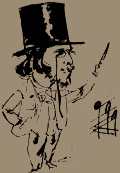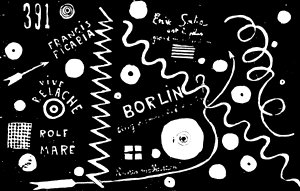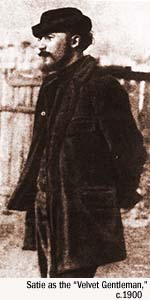 |
|
|||
| In the midst of an art opening at a Paris gallery in 1902, Ambient Music was born. Erik Satie and his cronies, after begging everyone in the gallery to ignore them, broke out into what they called Furniture Music-that is, background music-music as wallpaper, music to be purposely not listened to. The patrons of the gallery, thrilled to see musicians performing in their midst, ceased talking and politely watched, despite Satie's frantic efforts to get them to pay no attention. Today, Furniture Music is unavoidable. Nowhere are we free from the tyranny of it; we can't walk into a store or deli without hearing the generally dreadful stuff drifting through the environment. As a matter of fact, people buy Ambient music to fill up the space, to make it easier to work in, to make love in, to relax in; today, there's a goddamned Furniture Music industry. When was the last time you were at a dinner party where there was no Furniture Music tinkling away in the background? Over the years, a number of extraordinary musicians have paid tribute to Erik Satie: Brian Eno's made some pretty damn good Furniture Music and Richard James, a.k.a. Aphex Twin, is an acknowledged master of the genre. Indeed, the entire Muzak phenomenon-not to mention LiteFM-owes a debt to The Velvet Gentleman. But it's not only the Ambient folks that claim Satie as patriarch-just about every radical musical movement in this century can trace its roots back to Satie. Take John Cage, for example. His entire career-and, as a result, the course of music in the 20th Century-took a turn after being exposed to a strange little 3 minute piece of Satie's called Vexations. It's only a single page of music but it has the instructions "to be repeated 840 times" scrawled on it. For years it had been written off as a musical joke-a performance of the piece would take approximately 20 hours-an impossible, not to mention tediously boring, task. John Cage, however, took it seriously and gave Vexations its first performance in New York in 1963. Ten pianists working in two hour shifts conquered the piece, which lasted 18 hours and 40 minutes. Cage later explained how performing Vexationsseverely affected him: "In other words, I had changed, and the world had changed... It wasn't an experience I alone had, but other people who had been in it wrote to me or called me up and said that they had had the same experience." Other people in Cage's circle at the time who might have shared the Vexationsexperience included La Monte Young, who went on to create his own consciousness-altering time-based environments and Yoko Ono, who gained fame with such Satiesque performances as Bed Piece with John Lennon, in which the couple stayed in bed for a week to protest the Vietnam War. The religious vibe that many people have gotten from Vexations is no coincidence. Satie, naturally drawn to strange religions, was a Rosicrucian for a while in the 1890s. It was here that he was introduced to the mystical strains of Gregorian and Plainsong chant-music that would influence everything Satie would do for the rest of his career. The ethereal, aloof, and impersonal music went against everything Wagnerian, the rage of the moment in Paris. As a matter of fact, Satie composed his most famous works, the Gymnopédies, while under the spell of the Rosicrucians. However he quickly grew disillusioned with the Rose+Croix and, having acquired an even stronger appetite for ritualistic music and quasi-religious ceremony, went on to form his own short-lived church, L'Eglise Métropolitaine d'Art de Jésus Conducteur. The scope of Satie's church was classic Outsider-almost something out of Adolf Wolfli.
Satie supported the church (as well as his musical aspirations) by playing piano in a famous Montmartre cabaret, the Chat Noir. During his tenure there, Satie knocked out a number of stunning bawdy cabaret tunes as well as impressing a young composer, Claude Debussy, who hung out at the place. Debussy immediately recognized the genius in Satie and fell under his influence. Not too long afterwards, Debussy and his friend Maurice Ravel began writing Satie inspired pared-down music that soon snowballed into the world famous movement known as French Impressionism. Satie, ever the oddball, was left in the dust and it wasn't until Debussy and Ravel were firmly established many years later that they finally fessed-up to Satie's influence. While Debussy and Ravel were getting rich and famous, Satie remained dirt poor-so poor, in fact, that he was given the title "Monsieur le Pauvre" by his friends. In 1898, he moved from Montmartre to a cheap industrial suburb of Paris, Arcueil, where he would spend the rest of his life. No one ever set foot in Satie's room until his death some quarter century later. Around this time he began wearing his famous gray velvet suits-12 identical ones-earning himself the name "The Velvet Gentleman." He continued to commute by foot several miles each day to Montmartre to play at the cabarets and walked back home to the 'burbs every night with hammer in his pocket for protection. As he settled into Arcueil, his behavior became more eccentric. He detested the sun, wrote an enormous amount of letters to himself reminding him of his appointments, and refused to wash his hands with soap, favoring pumice stone instead. However, his most extreme behavior was his eating. In his book Memoirs of An Amnesiac, Satie described his eating habits: "My only nourishment consists of food that is white: eggs, sugar, shredded bones, the fat of dead animals, veal, salt, coconuts, chicken cooked in white water, moldy fruit, rice, turnips, sausages in camphor, pastry, cheese (white varieties), cotton salad, and certain kinds of fish (without their skin). I boil my wine and drink it cold mixed with the juice of the Fuchsia. I have a good appetite, but never talk when eating for fear of strangling myself." In 1905, at the age of 40, after having been kicked around by critics and his peers, Satie decided to go back to school to study the "proper" classical techniques of counterpoint and theory. He sat in classes with students half his age, honed his skills, and graduated four years later with flying colors. While he composed some "serious" works after graduating, his music continued to become more bizarre. He began scribbling mysterious directions all over his scores and gave a running commentary of dialogue, puns, and absurdities: to be jealous of one's playmate who has a big head, the war song of the King of Beans, canine song, to profit by the corns on his feet to grab his hoop, and indoors voice. The titles, too, were remarkable: Veritable Flabby Preludes (for a Dog), Sketches and Exasperations of A Big Boob Made of Wood, Five Grins or Mona Lisa's Moustache, Menus for Childish Purposes, and Dessicated Embryos, just to name a few. Much of the music, to my ears, is pop; the tunes are knowable and humable. For the most part, it's upbeat stuff: rowdy and really funny. And quite beautiful. Most of Satie's work was written for piano. His Trois Gymnopédies, a tinkling piano suite that you would immediately recognize if you heard it, has been abused in the media for decades as "soft, sentimental" Muzak. On the other hand, his Parade (1917), a collaboration with Jean Cocteau, Picasso, and Serge Diaghilev, rocks and rolls for 20 minutes and was the first classical work to employ a battery of sirens, car horns, typewriters, guns, and blasting percussion. The piece outraged so many people that there was a riot the first night it opened, and the collaborators were smeared all over the Parisian press, turning the 51 year-old Satie into a star overnight. In its experimentation, Parade opened the doors for all types of mechanical music to come later this century; musique concrete, techno, and industrial music all trace their lineage back to Parade.
Following Cage's premiere of Vexations, a flood of previously unavailable recordings appeared on the market to slake the 60s experimentalists thirst. Today there remains an enormous amount of records around, both in print and used. The best place to start is with Aldo Ciccolini's definitive set of Satie's complete piano works, Piano Music of Erik Satie, Vols. 1-6, on EMI Angel. Ciccolini's sound is warm and fresh, the playing magnificent and, in doing Satie's entire piano repertoire, many of the pieces make their first recorded appearances on these discs. (Warning: stick to the LPs and avoid the CD versions which were re-recorded later and have no punch). Once you're hooked on the piano works, there's a bunch of great orchestral pieces to check out. Pick up any recording of Gymnopédies Nos. 1 & 3, which were orchestrated by Debussy. These hackneyed pieces, heard ad infinitum, sound incredibly fresh when re-heard in an orchestral framework; their beauty is restored once again. The same goes for Parade-it's hard to make a lousy version of it. I prefer the vintage recordings to the newer digital ones-the new recordings are too slick- the sirens are too modern, and the typewriters sound more like word processors. John Oswald a.k.a. Plunderphonic recently did an incredible cut-up version of Parade that appears on a RecRec sampler. Like John Oswald, a lot of musicians have gotten juiced on Satie's eccentricity and freedom. In the 60s, there were some pretty strange attempts to imitate the wackiness of Erik Satie, the gooviest being The Electronic Spirit of Erik Satie featuring the Moog Synthesizer with the Camarata Contemporary Chamber Orchestra (London/ Deram XDES 18066, LP). The record is essentially a seance performed by a bunch of stoned hippies to try to invoke the spirit of Satie from the grave through the medium of the Moog Synthesizer. Oddball pieces such as Sports et Divertissements (1914) are hepped up to sound like a cross between Perrey & Kingsley, Cheech & Chong, and After Bathing At Baxter's.
Finally, there seems to be a booming Erik Satie industry thanks to Trip Hop and Ambient music; as folks gravitate to a more laid-back dreamy state, Satie makes more and more sense. Last year Folk Implosion based a noir Trip Hop piece, Wet Stuff, on the opening notes of Satie's Trois Gnossiennes and a few years ago, Malcolm McLaren used the same riff throughout his entire disc, Paris. DJ Spooky sites Satie as a major influence in many of his diatribes as well as incorporating Satie samples into his mixes. However, there's one recent use of Erik Satie that proves once and for all that his time has finally come: Brian Eno's Windows '95 Startup Sound. In my opinion, Eno has written a pocket symphony to rival (and could not exist without) Vexations. Both are concentrated miniatures, both are resistant to familiarity, and both stand up to countless repetitions. The only difference is that Satie never got a million bucks to write his. | ||||
Kenny G'sUnpopular Music airs every Tuesday from Noon-3. He often usesThe Electronic Inspirations of Erik Satie as his groovy talkover music. | ||||
|
WFMU Homepage | LCD Contents page | Hear Our Signal |
||||
|
© 1998 WFMU.
All rights reserved. Reproduction in whole or in part in any form or medium without express written permission of WFMU is prohibited. |
||||
 Satie
envisioned 1,600,000,000 converts dressed in black robes and gray hoods
defending the Church against attack with armaments consisting of
oversized battle swords and medieval lances that were five meters in
length. He also self-published an "official" church journal whose sole
function was to gave Satie a soapbox upon which to rant against music
critics hostile to his work. Obviously, the church had only one
member.
Satie
envisioned 1,600,000,000 converts dressed in black robes and gray hoods
defending the Church against attack with armaments consisting of
oversized battle swords and medieval lances that were five meters in
length. He also self-published an "official" church journal whose sole
function was to gave Satie a soapbox upon which to rant against music
critics hostile to his work. Obviously, the church had only one
member. From Parade until
his death in 1925, Satie lived the life of a celebrity. He found himself
surrounded by a group of young followers, Les Six, who revered the old
man and carried out his advances to radical extremes. It's worth
checking-out the work of Darius Milhaud, the most prominent of Les Six
who uses a slew of jazz, mechanical, and world music devices in his
compositions. As a result of the World War II diaspora, Satie's
influence manifested itself in completely unexpected ways: Milhaud found
himself teaching at Mills College in Oakland, the American postwar
experimental music hotbed. Among Milhaud's students were Morton
Subotnick, Robert Ashley, Pauline Oliveros, and Phil Lesh; there's a
direct connection from Parade to Dark Star.
From Parade until
his death in 1925, Satie lived the life of a celebrity. He found himself
surrounded by a group of young followers, Les Six, who revered the old
man and carried out his advances to radical extremes. It's worth
checking-out the work of Darius Milhaud, the most prominent of Les Six
who uses a slew of jazz, mechanical, and world music devices in his
compositions. As a result of the World War II diaspora, Satie's
influence manifested itself in completely unexpected ways: Milhaud found
himself teaching at Mills College in Oakland, the American postwar
experimental music hotbed. Among Milhaud's students were Morton
Subotnick, Robert Ashley, Pauline Oliveros, and Phil Lesh; there's a
direct connection from Parade to Dark Star. My favorite
Satie record is Erik Satie: Selected Works (Erato MHS 4700W, LP)
performed by the Ars Nova Ensemble with Marius Constant conducting. The
record is packed with historical gems and contains the only recorded
version of Furniture Music that I know of. The piece consists of three
movements: Curtain of a Voting Booth, Tapestry of Wrought Iron,
and Phonic Tiles-may be performed at a luncheon, each more
repetitive and banal than the next; Satie makes Eno's Music for
Airports seem exciting by comparison. The LP also contains a
prescient Minimalist piece from 1924, Relâche, which was
the score for a collaboration Satie did Marcel Duchamp and Francis
Picabia. Eleven repetitions (13 minutes) of Vexationsfinish out
this disc and while there have been many attempts to record
Vexationsover the years, most of them have proven fruitless: one
LP I own contains a number of repetitions whereby the last chord of the
final repetition ends with a lock groove, to suggest infinite playing
time (ah, vinyl....). However, with the advent of the CD, it is possible
to listen to all 18 hours and 40 minutes of Vexationsusing the
repeat function on CD players.
My favorite
Satie record is Erik Satie: Selected Works (Erato MHS 4700W, LP)
performed by the Ars Nova Ensemble with Marius Constant conducting. The
record is packed with historical gems and contains the only recorded
version of Furniture Music that I know of. The piece consists of three
movements: Curtain of a Voting Booth, Tapestry of Wrought Iron,
and Phonic Tiles-may be performed at a luncheon, each more
repetitive and banal than the next; Satie makes Eno's Music for
Airports seem exciting by comparison. The LP also contains a
prescient Minimalist piece from 1924, Relâche, which was
the score for a collaboration Satie did Marcel Duchamp and Francis
Picabia. Eleven repetitions (13 minutes) of Vexationsfinish out
this disc and while there have been many attempts to record
Vexationsover the years, most of them have proven fruitless: one
LP I own contains a number of repetitions whereby the last chord of the
final repetition ends with a lock groove, to suggest infinite playing
time (ah, vinyl....). However, with the advent of the CD, it is possible
to listen to all 18 hours and 40 minutes of Vexationsusing the
repeat function on CD players.